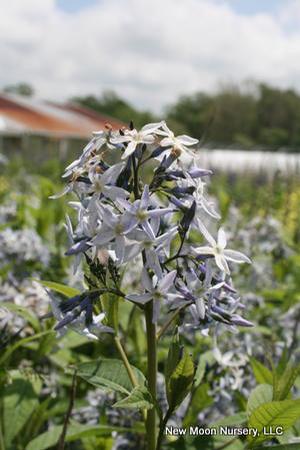New Moon Nurseries

This selection of bluestar is a nice perennial for the ornamental landscape and attracts pollinators.
Amsonia tabernaemontani 'Grande'
Bluestar
Native to North America (cultivar)
FIRST IMPRESSIONS: Bluestar boasts a striking growth habit, clean attractive foliage and pale blue starry flowers. Plants develop a handsome shrub-like form with dense growth and yellow fall color. This resilient native is adaptable to most garden situations and is tough enough to require almost no maintenance. This plant grows robustly and has flowers that are much larger than normal.
HABITAT & HARDINESS: Bluestar thrives in most of the Eastern United States usually in moist mostly sunny sites. Plants are hardy in USDA Zones 5-9.
PLANT DESCRIPTION: Eastern Bluestar is a sturdy warm season perennial. Plants have a lovely vase-shaped growth habit that becomes more striking with age. Mature plants average 3’ tall and 3’ wide
Foliage narrowly oval or lance shaped. Blooms are large, lavender blue and star shaped. During autumn, foliage is tinted in a lovely clear yellow shade.
CULTURAL & MAINTENANCE NEEDS: This Bluestar is very adaptable and easy to grow. It tolerates moist sandy to heavy clay soils and is drought tolerant once established.
It thrives in full sun or partial shade but may flop is shade is too dense. If flopping occurs, plants can be pruned back so that stronger shorter stems can develop.
The slightly toxic latex sap cause this plant to be unpalatable to insect pests and foraging herbivores like deer and rabbits. It is host to the coral hairstreak butterfly caterpillar. Ruby throated hummingbirds, large carpenter bees, hummingbird moths and butterflies seek the floral nectar.
LANDSCAPE USES: Large flowers and a striking vase shaped growth habit allow this Bluestar to perform well as an Accent plant. It can also be used as a Butterfly Nectar Plant, Butterfly Host Plant or as part of a Group or Mass. Plants inject seasonal interest (Fall Color and Showy Blooms) into the garden and are valuable components of Cottage Gardens, Deer Resistant Plantings, Water-wise Landscapes, Low Maintenance Plantings, Meadow or Prairie Gardens, Perennial Borders, Shade Gardens, Wetlands and Wildlife Gardens.
COMPANION & UNDERSTUDY PLANTS: Bluestar blooms coincide with those of meadow phlox, false indigo and beard tongue. The golden fall foliage is attractive with fall asters like ‘Raydon’s Favorite.
Other Amsonias like the closely related Willow Amsonia can be substituted if this one is not available.
TRIVIA: Amsonia is a member of the Dogbane Family (Apocynaceae). Family members like the infamous oleander typically have milky or viscous sap that can be loaded with highly toxic alkaloids. The Bluestars’ latex sap is mildly irritating and not considered to be harmful to humans. It does make the plant unappealing to foraging rabbits, deer, insects and slugs and other garden pests.
Selected for its robust growth and larger than normal flowers.
Height:
2-3 ftSpread:
2-3 ftSpacing:
2 ftUSDA Hardiness Zone:
5-9Bloom Color:
BlueAmsonia tabernaemontani 'Grande' Characteristics
Attributes
- Interesting Foliage
- Rain Garden
- East-Coast Native
- Dried Flower
- Cut Flower
- Clay Soil
- Bog
- Naturalizing
Exposure
- Full Sun to Partial Shade
Flowering Months
- June
- May
Foliage Color
- Green
Soil Moisture Preference
- Moist